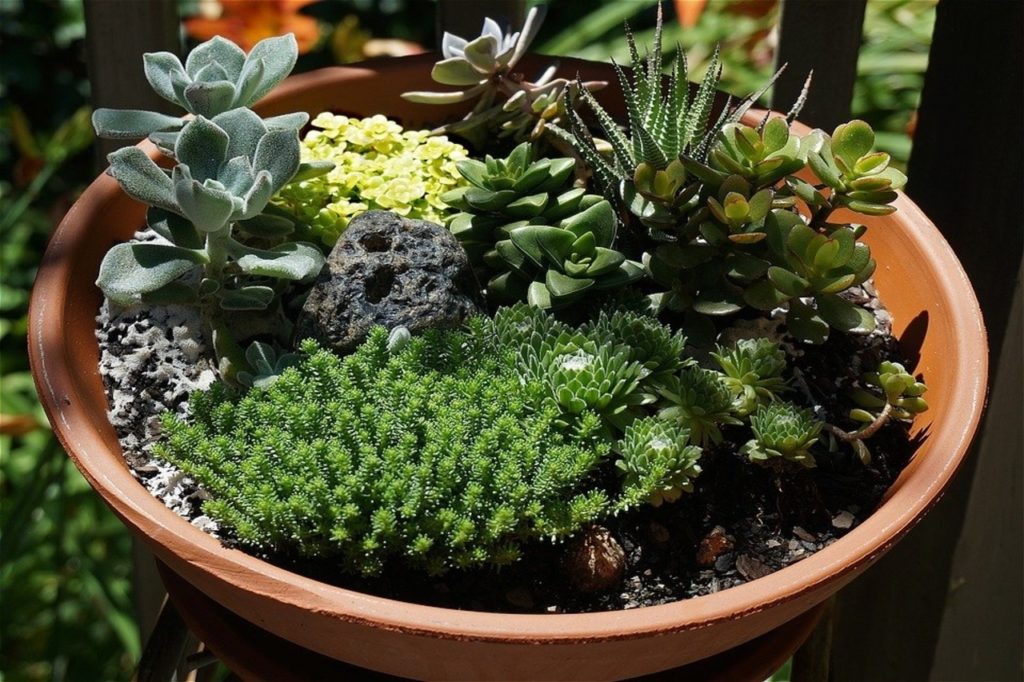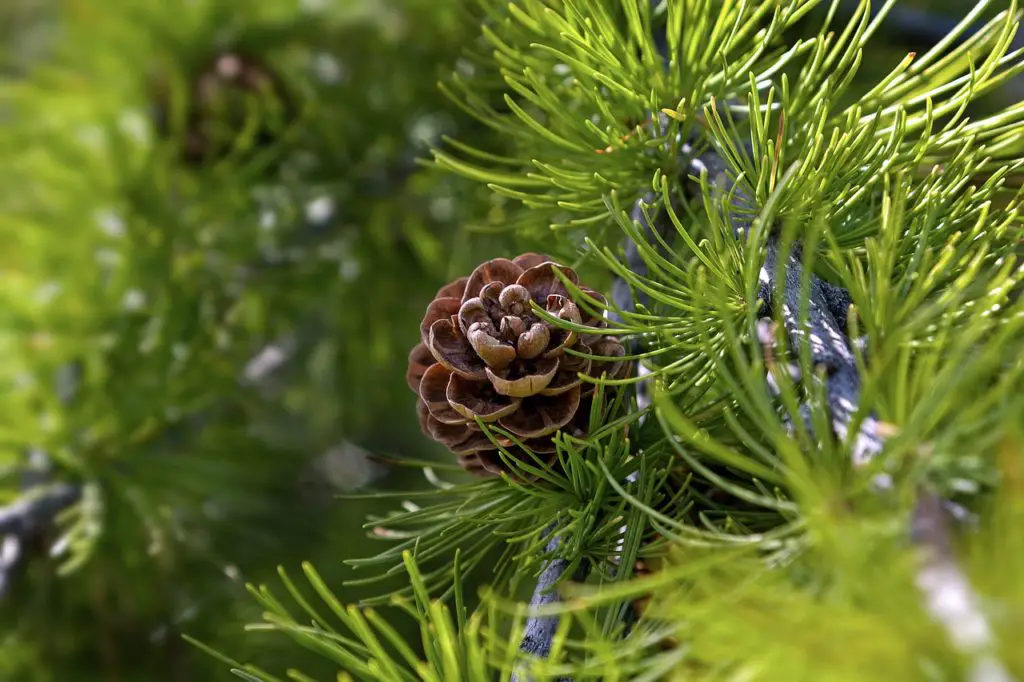The best mulch for clay is shredded leaves due to the numerous benefits it offers. It invites worms and other soil organisms to live beneath it. These organisms form aeration tunnels through the clay, breaking the soil structure.
You’ll need to be adding shredded leaves throughout the growing season. This is because they decompose quickly.
Shredded leaves are readily available; that’s another reason why they are the preferred option by many. You can find leaves almost anywhere there is a tree. Unlike other forms of mulching, you won’t have to ruin the environment to get them, such as cutting down trees.
Shredded leaves are also prepared very quickly. Running a lawn mower over leaves is one of the simplest ways to prepare the mulch.
In addition to mulch, cover crops are an excellent way to improve clay soil in resting garden beds.
Also Check – Mixing Wood Chips In Clay Soil
Is Sawdust Good For Clay Soil?
To boost organic matter and improve the texture of your soil, add modest amounts of sawdust. Sawdust works incredibly well in moist soil due to its high absorption rate.
Small wood particles, such as sawdust, actually leach nitrogen from the soil to aid in decomposition. This causes your nitrogen-loving plants to suffer. As a result, you should never use sawdust with short-seasoned crops.
Is Mulch Good for Clay Soil?
Mulch is beneficial to clay soil in a variety of ways. Because water doesn’t soak as quickly in clay soils as it does in other soils, it accelerates water runoff.
As a result, mulching gives the clay more time to absorb the water. Also, mulching prevents water from carrying fertilizer chemicals into surrounding water bodies.
Mulching in the summer helps keep the clay ground from hardening and cracking. It accomplishes this by slowing the rate at which water evaporates. Also, it makes the earth cooler by reducing the intensity of sunlight falling on the ground.
The clay soil becomes less sticky by coating it with a thick layer of organic compounds. These compounds may include tree bark, rough compost, and shredded wood. This makes farming easier because the clay sticks less to your farming equipment.
Mulching also minimizes weed germination by blocking sunlight from reaching the soil. Or by preventing the seeds blown into the farm from finding the ground.
Should You Mix Clay Soil and Sand?
No! Although loamy soil is a mixture of sand, organic materials, and clay. The end material mimics concrete and not loamy soil when adding sand straight to clay.
This treatment makes the soil so hard that worms can’t live in it. Hence, unhealthy plant growth.
Can Compost Mulch Improve Clay Soil?
Yes, compost can help improve clay soil’s structure and nutrient levels. Microorganisms break down organic resources like leaves and kitchen trash to produce compost. Compost usually is black, crumbly material.
Compost, unlike humus, isn’t decomposed. Small fragments of waste, such as twigs and leaves, are found in compost.
Microbial activity in compost injects nutrients and minerals into the clay soil. As a result, the clay soil in your garden becomes more fertile and nutrient-dense. Additionally, as these microorganisms burrow through the clay, the clay structure breaks down. As a result, applying compost to clay soil enhances the soil structure dramatically. Hence, making plants healthier.
Check to see if the compost adequately matured. It’s best to utilize compost that you’ve made yourself. Conversely, if you’re using manure that you’ve purchased, you should proceed with caution.
You must ask inquiries and verify that the animal never ate any sprayed materials. Also, don’t use sprayed hay in your garden. If you do, you may end up with a bed of dead or unhealthy plants.
Is Straw Mulch Good for Clay Soil?
Another fantastic mulch for clay soil is straw. People commonly use grain stalks to make straw mulch. The typical grain stalks used are wheat, oat, or barley.
During the summer, evaporation causes the soil to lose water. As clay loses water, it hardens, making it poor for farming.
You’ll have avoided these situations by utilizing straw mulch.
The clay soil also becomes more fertile as the straw decomposes. Its other benefit includes weed suppression.
It would be best if you used straw with caution. You should check to see if the farmer had sprayed it with chemicals.
Otherwise, the straw destroys the soil’s short microorganisms, causing more harm than benefit.
Because of straw’s immense surface area, people find it best to use it in large farms.
Are Shredded Leaves Mulch Good For Clay Soil?
If you have any shredded leaves lying around, use them as mulch for your clay farm. By creating space between compacted particles, shredded leaves help improve the soil’s structure. These help with aeration and drainage in the soil.
Run them over with a lawnmower to shred them. Alternatively, you can rake the leaves and shred them with a leaf shredder.
It’s worth noting that shredded leaves degrade quickly. As a result, you’ll have to reapply from time to time.
How Do Wood Chips Modify Clay?
One of the most cost-effective strategies to improve clay soil quality is to use wood chips mulch. Because wood chips hold moisture, they act as small sponges.
They’ll slowly release moisture throughout the day when it gets hot. They also help insulate the earth, preventing rainwater from evaporating as quickly.
A layer of mulch on top of the soil assists in regulating the temperature. The soil beneath the wood chips is slightly cooler on scorching days. When the temperatures drop, the earth remains insulated for a little longer.
Wood products can bind nitrogen in the soil, causing plant nitrogen shortage. Soil microorganisms to break down the wood use nitrogen.
As microorganisms complete the decomposition process, nitrogen becomes free. The nitrogen becomes available to plants again over months to years.
As a result, you shouldn’t use wood chips for fast-growing veggies or other plants. However, if you’re planting trees that take years to develop, you can use wood mulch.
How Do You Mulch Clay Soil?
It’s preferable to enhance the soil of the entire farm at once. It would help if you didn’t try to improve the soil in individual planting holes as you need them.
Your plant shall grow ideally for a while if you dig and prepare just the planting holes. The problem comes when the roots reach those bordering clay sides.
It’s critical to mulch around the base of your plants in the summer while gardening in clay soil. This is especially true in clay soil since it forms a crust that repels water. Combine a barrier, such as paper or plastic mulch, with straw or wood chips on top.
This aids in retaining moisture in the soil and the management of weeds. Also, it aids in the temperature at the base of the plants.
What Can You Add to Clay Soil To Break It Up?
When it comes to loosening soil and making it less dense, a gypsum mulch is a way to go. Gypsum breaks down clay into small crumbly particles. This makes clay easier to deal with and improves its drainage.
You may need to repeat the operation if the soil is dense clay.
Another way to improve clay soil’s texture is to use lime. Lime makes the acidic clay soils’ pH rise until it becomes more alkaline. In turn, this enables clay particles to stick together in small clumps.
Due to the formation of these particles, the soil becomes more brittle and easier to use.
You can also break clay soil by adding organic matter to it. Organic materials such as animal waste and straw improve soil aeration by further pulling the soil apart.
Put 4 to 6 inches of decaying straw or hay on top of a section of clay soil that you won’t be utilized for a year.
Then leave it to sit for a year. You won’t have to dig because this long process breaks up the soil organically.
Is Sawdust Good For Clay Soil?
To boost organic matter and improve the texture of your soil, add modest amounts of sawdust. Sawdust works exceptionally well in the moist area as it tends to absorb water easily.
Small wood particles, such as sawdust, actually leach nitrogen from the soil to decompose. In turn, this deprivation causes your plants to suffer.
As a result, you should never use sawdust with short-seasoned crops such as vegetables.
How Can I Improve Clay Soil Cheaply?
Dig in a lot of bulky organic stuff like manure or decomposed bark. In turn, this shall significantly improve clay’s functional characteristics, such as aeration.
It would also be best to use organic mulches around trees, shrubs, and other permanent plants. This helps to prevent summer cracking by conserving moisture.
Please don’t walk on or work with wet clay soil; this would make it compacted. In turn, these lessen the spaces available for air, water, and nutrients to reach the roots.
Putting down wooden boards on garden walkways is one option to prevent this.
Does Pea Gravel Make Good Mulch?
Yes! Pea gravel makes a good mulch. Although, it must be sharp-edged pea gravel rather than rounded pea gravel. This roughness around the edge allows air pockets to form in the clay. This makes it more porous, allowing plants to root better and absorb nutrients.
The best part is that the gravel stays put, unlike organic additives, which decompose.
Pea gravel is inexpensive, doesn’t decay like wood mulch, and requires little upkeep.
So, How Do You Put Pea Gravel Down?
You put pea gravel down by:
- Loosening the clay soil’s top layer.
- Spreading 2-3 inches of pea gravel on the ground.
- Adding an equal amount of organic material on top of that.
- Finally, digging to a depth of about 8 inches while mixing the clay, gravel, and organic material.
FAQ
How Do I Improve Drainage on Clay Soil?
You improve drainage on clay soil by adding organic compost, such as composted leaves to thick clay to improve its structure. As a result, drainage and compaction issues shall reduce. Avoid using sand because it exacerbates the condition.
How Can I Check the Drainage of Clay Soil?
You can check the drainage of clay soil by filling a 0.6m deep hole with water and leave it for 24 hours. If the water is still there, you have inadequate drainage.
Can I Use Whole Leaves As Mulch?
No, putting whole leaves in your plant beds makes a thick mat that keeps air and moisture out. As a result, you’ll need to shred them first to allow drainage and aeration.
When Should You Mulch Clay Soil?
In the summer, you’ll need to mulch to minimize water loss, which might cause tightening of the clay. You’ll also need to mulch in the spring to prevent water runoff. Mulching in the spring provides enough time for water to drain through the soil.
Conclusion
Never heed your sixth sense when it urges you to combine clay with sand to loosen it. Only regular infusions of organic matter and careful treatment enhance your clay soil.
Also, avoid working on clay soil when it’s still wet. Because this causes it to harden, making it difficult for plants to grow in.
When it comes to mulching, avoid sawdust mulch like the plague. Mulching in this manner removes all of the nitrogen from the soil.
Finally, use shredded leaves for mulching since it’s easy to use and prepare. It’s also available in abundance.


